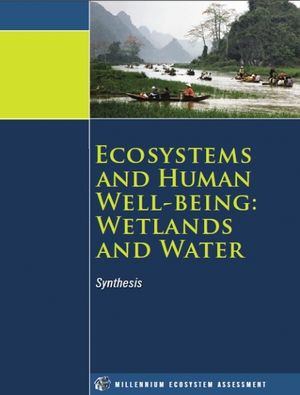Ecosystems and Human Well-being: Wetlands and Water: Key Messages
This is part of the Millennium Ecosystem Assessment report Ecosystems and Human Well-being: Wetlands and Water.
Synthesis Team Co-chairs: C. Max Finlayson, Rebecca D’Cruz, Nick Davidson
Synthesis Team Members: Jacqueline Alder, Steve Cork, Rudolf de Groot, Christian Lévêque, G. Randy Milton, Garry Peterson, Dave Pritchard, Blake D. Ratner, Walter V. Reid, Carmen Revenga, María Rivera, Frederik Schutyser, Mark Siebentritt, Mishka Stuip, Rebecca Tharme
Contributing Authors: Stuart Butchart, Ellen Dieme-Amting, Habiba Gitay, Steve Raaymakers, Douglas Taylor
Extended Writing Team: MA Coordinating Lead Authors, Lead Authors, Contributing Authors, and Working Group Coordinators
Review Editors: José Sarukhán and Anne Whyte (Co-chairs) and MA Board of Review Editors
- Wetland ecosystems (including lakes, rivers, marshes, and coastal regions to a depth of 6 meters at low tide) are estimated to cover more than 1,280 million hectares, an area 33% larger than the United States and 50% larger than Brazil. However, this estimate is known to under-represent many wetland types, and further data are required for some geographic regions. More than 50% of specific types of wetlands in parts of North America, Europe, Australia, and New Zealand were destroyed during the twentieth century, and many others in many parts of the world degraded.
- Wetlands deliver a wide range of ecosystem services that contribute to human well-being, such as fish and fiber, water supply, water purification, climate regulation, flood regulation, coastal protection, recreational opportunities, and, increasingly, tourism.
- When both the marketed and non-marketed economic benefits of wetlands are included, the total economic value of unconverted wetlands is often greater than that of converted wetlands.
- A priority when making decisions that directly or indirectly influence wetlands is to ensure that information about the full range of benefits and values provided by different wetland ecosystem services is considered.
- The degradation and loss of wetlands is more rapid than that of other ecosystems. Similarly, the status of both freshwater and coastal wetland species is deteriorating faster than those of other ecosystems.
- The primary indirect drivers of degradation and loss of inland and coastal wetlands have been population growth and increasing economic development. The primary direct drivers of degradation and loss include infrastructure development, land conversion, water withdrawal, eutrophication and pollution, overharvesting and overexploitation, and the introduction of invasive alien species.
- Global climate change is expected to exacerbate the loss and degradation of many wetlands and the loss or decline of their species and to increase the incidence of vector-borne and waterborne diseases in many regions. Excessive nutrient loading is expected to become a growing threat to rivers, lakes, marshes, coastal zones, and coral reefs. Growing pressures from multiple direct drivers increase the likelihood of potentially abrupt changes in wetland ecosystems, which can be large in magnitude and difficult, expensive, or impossible to reverse.
- The projected continued loss and degradation of wetlands will reduce the capacity of wetlands to mitigate impacts and result in further reduction in human well-being (including an increase in the prevalence of disease), especially for poorer people in lower-income countries, where technological solutions are not as readily available. At the same time, demand for many of these services (such as denitrification and flood and storm protection) will increase.
- Physical and economic water scarcity and limited or reduced access to water are major challenges facing society and are key factors limiting economic development in many countries. However, many water resource developments undertaken to increase access to water have not given adequate consideration to harmful trade-offs with other services provided by wetlands.
- Cross-sectoral and ecosystem-based approaches to wetland management—such as river (or lake or aquifer) basin-scale management, and integrated coastal zone management—that consider the trade-offs between different wetland ecosystem services are more likely to ensure sustainable development than many existing sectoral approaches and are critical in designing actions in support of the Millennium Development Goals.
- Many of the responses designed with a primary focus on wetlands and water resources will not be sustainable or sufficient unless other indirect and direct drivers of change are addressed. These include actions to eliminate production subsidies, sustainably intensify agriculture, slow climate change, slow nutrient loading, correct market failures, encourage stakeholder participation, and increase transparency and accountability of government and private-sector decision-making.
- Major policy decisions in the next decades will have to address trade-offs among current uses of wetland resources and between current and future uses. Particularly important trade-offs involve those between agricultural production and water quality, land use and biodiversity, water use and aquatic biodiversity, and current water use for irrigation and future agricultural production.
- The adverse effects of climate change, such as sea level rise, coral bleaching, and changes in hydrology and in the temperature of water bodies, will lead to a reduction in the services provided by wetlands. Removing the existing pressures on wetlands and improving their resiliency is the most effective method of coping with the adverse effects of climate change. Conserving, maintaining, or rehabilitating wetland ecosystems can be a viable element to an overall climate change mitigation strategy.
- The MA conceptual framework for ecosystems and human well-being provides a framework that supports the promotion and delivery of the Ramsar Convention’s “wise use” concept. This enables the existing guidance provided by the Convention for the wise use of all wetlands to be expressed within the context of human well-being and poverty alleviation.
Terms of Use
The copyright for material on this page is the property of the World Resources Institute. Click here for the Terms of Use (Ecosystems and Human Well-being: Wetlands and Water: Key Messages).
Disclaimer: This chapter is taken wholly from, or contains information that was originally written for the Millennium Ecosystem Assessment as published by the World Resources Institute. The content has not been modified by the Encyclopedia of Earth.
|
|
